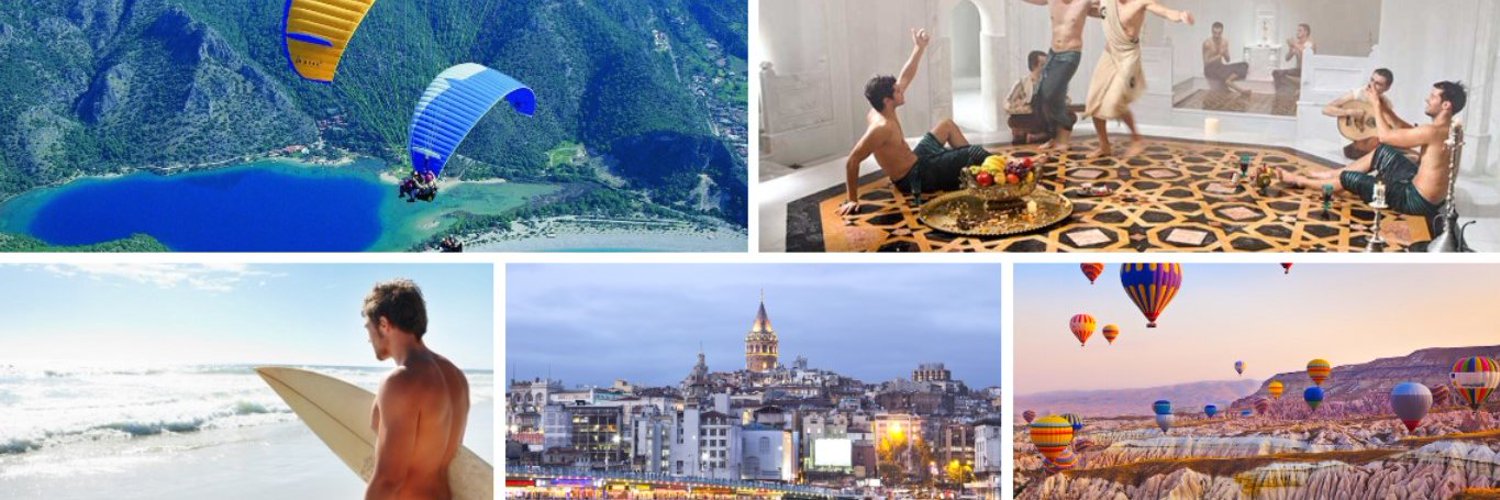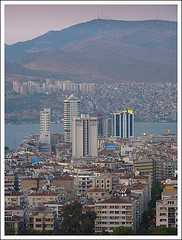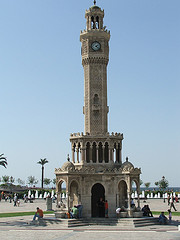|
|
|
|
|||||
|
|||||
|
|||||
|
|
|||||
|
|
|||||
|
|
|||||
|
|
|||||
|
|
|||||
|
|
|||||
|
|
|||||
Izmir is the pearl of the Aegean, a fascinating city whose history begins in the mists of legend. Turkey's third largest city and second most important port, Izmir is the center of tourism in the region. This modern city still retains traces of its ancient, Ottoman and Levantine past.
ALSANCAK:
A select neighborhood
with a unique character in modern Izmir. Stretching from the
waterfront esplanade inland most of the area has been
transformed into a pedestrian precinct, so there is no traffic
to disturb shoppers and strollers. The streets lined by modern
buildings and attractive shops lead onto the square where
Alsancak station stands. Dating from 1858 the colonial
architecture of the station distinguishes it in style from the
rest of the city. Trains to Buca, Aydin and Denizli depart from
here.
ANGLICAN CHURCH
: This church was
built in 1835 by Levantines of English extraction living in Buca.
The church is famous for its wood carving, beautiful stained
glass windows and huge organ.
ASANSOR:
The city's famous public elevator, and a symbol of Izmir. This
elevator links Mithatpasa street below with Halil Rifat Pasa
street at the summit of the precipitous hill. It was built in
1907 and restored by the municipality in 1993. The upper terrace
has a breathtaking view over the city and the bay. Here there is
an Open-air cafe, a restaurant and a Genoese tavern.
BALCOVA:
This spa is on the
outskirts of Izmir on the road to Urla and Çesme. Turn left at
Inciralti crossroads to reach Balçova thermal springs one
kilometer down the road. Known as the Agamemnon Springs in
antiquity, this may have been the first hydrotherapy center of
the ancient world. Today there are modern facilities for
visitors to the hot springs and luxury hotels. The temperature
of the water is 63 degrees C.
BARLAR SOKAGI:
Street of Bars. Some of the attractive old houses under
conservation order in Alsancak now house bars and restaurants.
BASMANE:
In this district are
Izmir's old fashioned shopping streets, the park where the
famous Izmir Fair is held each summer, and Basmane station. The
trains to Manisa, and suburban rail buses to ßornova and other
destinations leave from this station.
BORNOVA:
A suburb of Izmir, Bornova was the hub of the Levantine
community in the late l9th and 20th centuries. Today it houses
the campus of Ege University. The Izmir-Manisa road passes
through Bornova, which is linked to the city center by a 7 km
railway line.
BUCA:
Once Izmir's summer resort, Buca is today part of the city. With
a population of 200000 in 1990, Buca is today a commercial and
university district. The British Levantine merchants who ran
businesses in Izmir from the late l8th century onward s built
imposing mansions here. Not until the 1950s did Buca undergo
radical change as various institutions moved into the mansions,
whose extensive gardens are under conservation.
CLIMATE:
Typical Mediterranean
climate, with hot dry summers and warm wet winters. The average
temperature is 18 degrees C. Snowfall is extremely rare, and
approximately 148 days of the year are clear and sunny.
CLOCK TOWER:
Another symbol of the city, this picturesque clock tower in
Konak Meydan was built in 1901 to commemorate the 25th
anniversary of Abduhamit II's accession to the throne. The clock
itself was a gift of Emperor Wilhelm II of Germany. The 25 m
high tower is currently being restored.
CESME:
This popular and
attractive resort west of Izmir is famous for its modern hotels,
sparkling clean sea and wonderful sandy beaches.
EPHESUS:
An ancient city three km
from the town of Selcuk south of Izmir. During both the
Hellenistic and Roman periods Ephesus was the most important
port and cultural center of the eastern world. The remains of
the city are still spellbinding today. The magnificent temples,
public buildings, villas and streets of Ephesus have been
excavated and restored by the Austrian Archaeological Institute,
and it requires little effort to imagine the city as it was in
its heyday.
FOCA:
A picturesque fishing town 50 km north of Izmir. A magnet for
holiday makers during summer today, Foca was an important Ionian
town in antiquity. The Phokaians were famed for their commercial
prowess, courage and seamanship. They established trading
colonies at distant ports, and were the founders of the French
port of Marseilles (the ancient Massalia).
HISAR MOSQUE:
The city's most magnificent mosque in the district of Hisar next
to Kemeralti office complex. The mosque was built by Yakup Bey
in 1592. It is roofed by a large dome resting on eight piers,
and noted for the decoration on the altar niche and pulpit.
HOUSE OF THE
VIRGIN MARY: This
holy Christian shrine on Mt.Bulbul between Selcuk and Ephesus
was sanctified by Pope Paul VI in 1967, after the Vatican
confirmed that the Virgin Mary had spent the last years of her
life here. Numerous travel agencies in Izmir organize day tours
to the House of the Virgin Mary and Ephesus.
KADIFEKALE:
Velvet Castle, to be literal. This 4th century BC castle
commands a bird's eye view of Izmir and is th perfect place to
watch the sun set over the city.
KARSIYAKA:
The name of this district of Izmir on the north shore off Izmir
Bay means "opposite shore", as indeed it is. The inhabitants of
this pleasant residential area with its Own esplanade claim an
identity distinct from the rest of the city. In their view,
Karsiyaka is a town in its own right with an individual culture
and history.
KEMERALTI:
The old fashioned shopping district of Izmir, consisting of
narrow streets winding their way from Konak towards central
Izmir around Anafartalar Caddesi. Here you can find jewelers,
drapers, shoemaker, and shops specializing in all kind s of
goods from leather to olives and cheese. The atmosphere of an
earlier century still pervades the buildings here, with their
distinctive 19th century doorways and roof tiles.
KORDON:
The famous esplanade between Konak Meydan and Alsancak is packed
with promenades on weekends and fine evenings. As families and
young lovers hand in hand stroll along the waterfront,
horse-drawn phaetons with colourful ponpons swinging from the
harnesses es trot past, and cars cruise by.
PASAPORT:
(Not a printing error, but the Turkish for "passport). The name
for the dock and pier between Konak and Cumhuriyet Meydan.
Pasasaport Dock was built in 1876. The dock building is in the
Turkish revival style inspired by Ottoman and Selcuk
architecture which was popular in the 1920s and 1930s. Until not
so long ago the area was full of old fashioned coffee houses
which served waterpipes as well as tea and coffee, but today
pubs have supplanted most of them.
PERGAMUM:
The remains of this magnificent ancient city are situated north
of Imir. Founded in the early 3rd century BC, Pergamum was the
most powerful and extensive kingdom of Western Anatolia
throughout the Hellenistic period. Parchment is thought to have
been invented here. On the hill which rises steeply in the
center of Pergamum is the Acropolis and the world's steepest
amphitheatre with seating for 16,000 people. The remains of
temples Of Athena and Dionysus. The splendid altar of Zeus at
the entrance of the Acropolis was taken to Berlin Museum by Carl
Humann in 1871. A fligth of 20 steps leads up to this remarkable
structure, which dwarfs the room at Berlin Museum, as it awaits
expectantly the day when it will be released from confinement
and return to its hilltop site in Pergamum. The ruins of the
Asclepion on the plain below reveal almost all the original
features as a result of the excavations. Named after the god of
medicine Asclepios, this complex was one of the foremost health
centers of the ancient world.
SELCUK:
A town in the foothills of the Aydin mountains 94 km south of
Izmir. SeIcuk is the site of Ephesus Museum, a magnificent
castle and the 6th century Basilica of St.John. The road to the
resorts of Marmaris and Bodrum passes through Selcuk, w hile
Kusadasi, port of call for many yachts and cruise liners, is
just a twenty minute drive to the north.
SMYRNA:
The ancient name for Izmir and the heroic Amazon who founded the
city according to Herodotus and Strabon.
TEOS: The
ruins of Teos are set amidst olive groves at one end of Sigacik
harbor near Seferihisar, famous for its beaches and thermal
springs. Thales relates that Teos was selected as capital of the
league of twelve Ionian cities in the 7th century BC. The
largest temple of Dionysus ever built in Teos.
TEPEKULE:
Excavations at Tepekule in the district of Bayrakli have thrown
light on Izmir's early history. Izmir was originally a
settlement of the Aeolians, who were contemporaries of the first
Trojans, and dates back to the third milenium BC. The c ity was
subsequently occupied by the Ionians, and the Lydian King
Alyattes conquered the region in 600 BC, razing Izmir's temples
and houses. Today the ruins of the Temple of Athena and houses
can be seen at Tepekule. URLA: Urla is a resort 42 km from Izmir on the road to Cesme. Izmirians spend their summers and weekends here, the site of the ancient Ionian city of Klazomenai. This city was the birthplace of the illustrious philosopher Anaxogoras, and is latterly also famous for a local pastry dish "katmer" and for its meat and fish restaurants.
|
|||||
|
|
|||||
|
|
|||||
*




